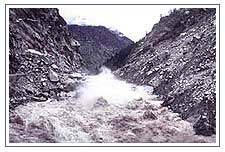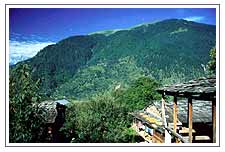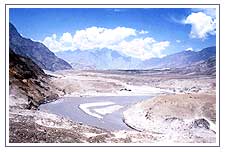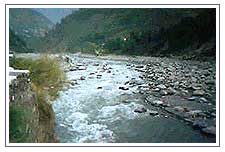Before the
birth of Pakistan this configuration of rivers was one of the most
magnificent features of the Indian sub-continent. Came 1947, the year of
partition and roughly two thirds of the length of this river system was
assigned to Pakistan. But the rivers still take birth on the Indian side and
still go crashing through the Himalayas to create some of the most
spectacular scenery to be found anywhere in the world.

They
are a source of life for man and beast alike, for the forests they nourish
and the crops they irrigate on course. These mountain rivers have taken
aeons crafting their valleys, spearheaded by glaciers, helped by natural
upheavals like earthquakes and the movement of the earth's plates and more
recently, thwarted by dams and hydel projects. They command awe and
reverence, not unmixed with fear.
The River Journey
The very names of these rivers roll like
music-Jhelum, Chenab, Ravi, Beas and Sutlej. Their ancient names were more
musical still: "Vitasta", "Askini", "Irawati",
"Vipasha" and "Shatadru". It is with Shatadru that one's
odyssey begins because it is the longest and fastest of these five rivers.
River Sutlej (also spelt as Satluj) takes birth on the
southern slopes of the holiest of mountains - Kailash, near the holiest of
lakes Mansarovar. After a long run, parallel to the Himalayas, it finally
penetrates these at Shipki pass. Later it cuts through the Zanskar range,
makes a diagonal thrust through the Himalayas and blasts a deep gorge at the
base of the Kinner Kailash massif. Within Kinnaur district, the Sutlej runs
parallel to the Hindustan-Tibet Road. At Karcham, in Kinnaur, it is joined
by the crystal clear, blue river Baspa that drains the Sangla valley. After
Karcham, the Sutlej turns aggressively, throwing boulders, rocks and rubble
around in mighty, foaming rapids.
But not or long! A dash through Shimla hills and Bilaspur district, and it
loses momentum, leaving Himachal and entering the plains of Punjab at Bhakra
where it mingles with the waters of Gobind Sagar Lake.
The path of the Sutlej can be a traveller's lifetime reward. To stand atop
the highest hill in Thanedar, all of 8,000 feet high, and see right down in
a gorge below the silver ribbon of the Sutlej at 2,000 feet. To stand at
Tattapani 51-km from Shimla and watch a languid Sutlej ripple past, even as
a hot spring froths and bubbles alongside. To travel along the
Hindustan-Tibet Road with the foaming, rolling, not-to-be-contained Sutlej
for a companion. These are pictures that never fade from the mind.
Sarahan
Sarahan is a former capital of Sutlej valley and a place with a charming
setting. Small streams, brimming with sparkling snow melt. Fields and
orchards surrounding slate roofed houses, trees of smooth birch, rare wild
flowers and medicinal herbs. But the main draw is the Bhimakali temple built
in the classical Shikhara style. The tall, tower like structure with its
unusual rooflines, dominates the scene. A wealth of woodcarving makes it a
showpiece.
Rampur
On the banks of river Sutlej stands Rampur, capital of the former princely
state of Bushahr. Rampur stands on an old trade route linking Himachal with
Tibet. It is still an important commercial centre where a variety of goods
are traded, particularly during the Lavi Fair held early November every
year. These include livestock, wool, shawls, blankets and dry fruits.
The Beas
forms the valleys of Kullu and Kangra, famed for their beauty. But
ironically, its source is an insignificant looking igloo like structure near
Rohtang Pass in Pir Panjal range to the north of Kullu. The main thrust of
this river is southward to Larji and then to the west. Where it enters Mandi
district and further still into Kangra. On account of its snow-fed,
perennial tributaries, its inflow increases greatly during the monsoons,
sometimes resulting in floods. At the Pandoh, in Mandi district, the waters
of the Beas have been diverted to the Sutlej through 53-km of tunnel, with
the Pong Dam constructed on the Beas, for the purpose of increasing the
hydroelectric power supply.
Go Angling!
During the British Raj, the Beas was well known as the angler's paradise.
Since then things have changed what with mounting pressures on natural
resources. But the most highly prized variety of fish, the Mahseer, has
shown a remarkable capacity for regeneration. The Pong Lake Reservoir for
feeding the Pong Dam, acts like a fish reserve, feeding the Beas every year
when the monsoons are on and fish must ascend the main river and its
tributaries for the spawning run. Larji is the place for splendid fishing.
Manali

On
its downward journey, Pine, clad mountains gradually close in on both sides
of the Beas till they almost meet. And nestling in their shade as though
carved out of primeval forest, is the hill resort of Manali. Manali was once
a scattered hamlet. Today it is a bustling town with a constant flow of
tourists and infrastructure to match. Despite the construction boom, Manali
is still beautiful what with the mountains, gracious trees and apple
orchards and or course the Beas, always a living presence.
The environs of Manali are most inviting - the village of Vashisht with its
hot springs and temple, Solang Valley with a glacier of its own and a
splendid view of other glaciers and snow peaks. And of course the
incomparably majestic Rohtang Pass. Manali is the real starting point of an
ancient trade route, which crossed the Rohtang, and Baralacha passes and ran
via Lahaul and Ladakh to Kashmir, Tibet and other remote countries of
Central Asia.
But the Beas is not linked with scenic beauty alone. To lakhs of people the
very name also means spiritual sustenance for, on the banks of the Beas, at
a place called Dera Baba Jaimal Singh stands the impressive Radha Swami
Centre.
There is
something intrinsically romantic about the river Ravi. In divided Punjab
used to ring with the haunting strains of love songs sung on the banks of
the Ravi, which flowed past the elite city of Lahore. Now one only has to
hear the outpourings of young hearts in Chamba celebrating the beauty of
love and nature to know that the spirit of the Ravi is the same everywhere.
Chamba
Chamba town rests on a mountain shelf on the right bank of the river. As a
settlement it is Indian to the core. Here, as in many ancient towns,
flourished a civilisation that provided patronage to the arts so that the
temple sculptures of Chamba are truly amazing. The region is also famed for
a number of handicrafts like the fabulously embroidered Rumals
(handkerchiefs), wood carving, silver and leather craft.
The heart of Chamba is the Chougan or Polo ground which is meant for any
activity that requires a wide-open space. A not-to-be-missed occasion in
Chamba is the Minijar festival. The word "Minijar" literally means
the tassel of a maize plant and the fair celebrates the flowering of the
maize crop, which occurs during the monsoon. An occasion for old rituals to
be revived, followed by much festivity, singing and dancing.
River Chenab
is sometimes called the Chandra Bhaga because it is composed of two streams
rise close to the Baralacha Pass and, by flowing in opposite directions, put
a girdle around a vast tract of Lahaul till, at Tandi, they unite to form a
master stream of great size and volume.
The Chenab, a tempestuous river, difficult to navigate, flows through
Lahaul, enters Kashmir near Kishtwar. Three places on the banks of the
Chenab deserve special mention. They are Triloknath and Mrikula Devi
embellished with beautiful images and woodcarving. A third place goes by the
name of Sisu, 36-km from Rohtang. Every spring and autumn migrating Geese
and Ducks halt here on their way to and from Siberia.
The Jhelum
flows from the spring known as Verinag, 80-km south of Srinagar. This wide,
swift flowing, muddy but picturesque river sweeps through Srinagar and is
famed for its nine old bridges among many things else.
Srinagar
Srinagar defies description. To explore it can be an amazing and deeply
rewarding experience. It has old mosques and temples, fancy stores and
hotels and ancient dark, queuing looking lanes lined with shops that sell
things typical of Kashmir. The Dal Lake has floating shops 'n' the shape of
light boats known as 'Shikaras' that ferry the pick of fresh vegetables,
fruits and local flowers, and people too. The environs of Srinagar are
beautiful. There are famous gardens around - the Nishat, Shalimar and
Chashma Shahi.
River Indus

En
route from Srinagar to Leh, one has to travel along the roaring, foaming,
turbulent, ash-grey Indus. Some 10-km northeast of the river, in a fertile
valley stands Leh, the capital of Ladakh. Centuries ago this was an
important stop on the old silk route to China.
Leh
But Leh is still where every tourist wants to go because the place is so
completely different from the areas leading up to it. Barren mountains
layered with rocks in different colours, like a surrealist painting. A
fabulous view of the snow clad Zanskar range across the Indus. Ancient,
mysterious Gompas. The air incredibly clear and crisp but the atmosphere so
rarefied one must take it very easy the first few days. What a place! What
an experience!


 They
are a source of life for man and beast alike, for the forests they nourish
and the crops they irrigate on course. These mountain rivers have taken
aeons crafting their valleys, spearheaded by glaciers, helped by natural
upheavals like earthquakes and the movement of the earth's plates and more
recently, thwarted by dams and hydel projects. They command awe and
reverence, not unmixed with fear.
They
are a source of life for man and beast alike, for the forests they nourish
and the crops they irrigate on course. These mountain rivers have taken
aeons crafting their valleys, spearheaded by glaciers, helped by natural
upheavals like earthquakes and the movement of the earth's plates and more
recently, thwarted by dams and hydel projects. They command awe and
reverence, not unmixed with fear.
 On
its downward journey, Pine, clad mountains gradually close in on both sides
of the Beas till they almost meet. And nestling in their shade as though
carved out of primeval forest, is the hill resort of Manali. Manali was once
a scattered hamlet. Today it is a bustling town with a constant flow of
tourists and infrastructure to match. Despite the construction boom, Manali
is still beautiful what with the mountains, gracious trees and apple
orchards and or course the Beas, always a living presence.
On
its downward journey, Pine, clad mountains gradually close in on both sides
of the Beas till they almost meet. And nestling in their shade as though
carved out of primeval forest, is the hill resort of Manali. Manali was once
a scattered hamlet. Today it is a bustling town with a constant flow of
tourists and infrastructure to match. Despite the construction boom, Manali
is still beautiful what with the mountains, gracious trees and apple
orchards and or course the Beas, always a living presence. 
 En
route from Srinagar to Leh, one has to travel along the roaring, foaming,
turbulent, ash-grey Indus. Some 10-km northeast of the river, in a fertile
valley stands Leh, the capital of Ladakh. Centuries ago this was an
important stop on the old silk route to China.
En
route from Srinagar to Leh, one has to travel along the roaring, foaming,
turbulent, ash-grey Indus. Some 10-km northeast of the river, in a fertile
valley stands Leh, the capital of Ladakh. Centuries ago this was an
important stop on the old silk route to China.